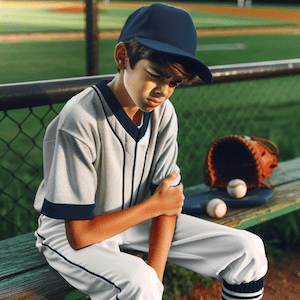Common Youth Arm Injuries
A Physiotherapist’s Guide
Introduction
Children and adolescents often encounter unique arm injuries due to their bones still growing. This growth involves cartilaginous growth plates (physis), which are crucial for bone development but also vulnerable to damage from repetitive stress or sudden forces. As a physiotherapist, I frequently see these types of injuries and understand the importance of early intervention and proper management.
Throwers Elbow in Children
One common injury among young athletes, particularly in sports like baseball and cricket, is throwers elbow. This condition results from repetitive overhand throwing, which puts significant stress on the elbow’s growth plates. Continuous strain can damage ligaments, cartilage, and these sensitive growth areas. It’s essential to recognise the symptoms early and manage them appropriately.

Medial Apophysitis (Little Leaguer’s Elbow)
Medial apophysitis, often called Little Leaguer’s Elbow, typically affects active children. This injury causes pain at the medial epicondyle, the inner part of the elbow. Excessive throwing movements, common in tennis and baseball, can inflame the growth plate in this area, leading to pain and swelling.
Osteochondritis Dissecans
Osteochondritis dissecans is another injury resulting from overuse, especially in throwing sports. It involves the compression of the elbow joint’s immature bones, potentially causing small fragments of bone and cartilage to dislodge. This condition may require surgical intervention if not addressed promptly.
Stress Reactions of Growth Plates
Growth plates in the arms and legs can suffer from repetitive stress, impacting a child’s growth and causing pain. Sports like gymnastics and baseball are particularly notorious for causing these stress reactions. If these injuries are not managed correctly, they can lead to permanent damage to the growth plates and even halt bone growth prematurely.
Latest Research and Preventative Measures
Recent studies emphasise the importance of rest and proper technique in preventing these injuries. A study published in the Journal of Paediatric Orthopaedics (2023) highlights that early intervention and adapting sports techniques can significantly reduce the risk of arm injuries in young athletes.
What to Do? Professional Advice for Managing Youth Arm Injuries
Early Detection: Be vigilant for signs of pain or discomfort in your child’s arms, especially if they are active in sports.
Rest and Recovery: Ensure adequate rest periods between sports activities to allow the body to recover.
Professional Assessment: If you suspect an injury, consult a physiotherapist or doctor experienced in youth injuries.
Customised Treatment Plans: Every child is unique, and their treatment should be tailored to their specific needs.
Education and Awareness: Teach children about the importance of proper technique and listening to their bodies.
Conclusion
Managing youth arm injuries requires a comprehensive approach that includes early detection, rest, and professional guidance. As a physiotherapist, I can’t stress enough the importance of addressing these injuries promptly to prevent long-term consequences. Remember, the best treatment is often prevention, and educating young athletes and their parents about the risks and management strategies is key to maintaining healthy, active lifestyles.
Your Next Steps
If your child is experiencing arm pain or discomfort, especially related to sports, don’t hesitate to seek professional advice. A physiotherapist can provide a thorough assessment, guide you through the recovery process, and help prevent future injuries. Remember, early intervention can make a significant difference in your child’s health and athletic career.



